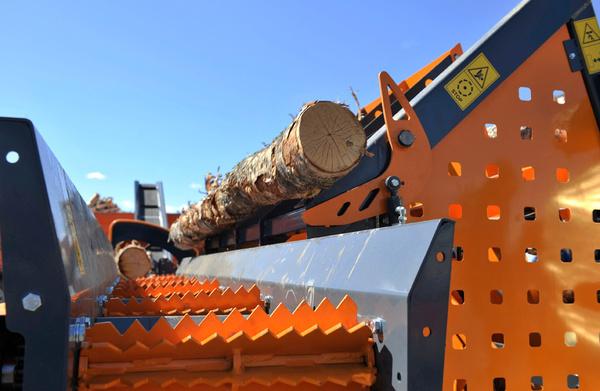Types of Log Splitters
Log splitters are essential tools for efficiently handling large quantities of wood, a necessity for any farm or wood processing operation. There are several types of log splitters available, each suited to different needs and volumes. Manual log splitters are a basic option, requiring physical effort and are ideal for smaller tasks or where electricity isn’t available. Electric log splitters, on the other hand, offer a more convenient solution, providing consistent power for moderate workloads. These are perfect for residential use and small-scale wood processing.
For those dealing with large quantities of wood, gas-powered log splitters are the most powerful option. They deliver high splitting force, making them capable of processing larger logs quickly. This type is particularly beneficial for commercial operations or large farms where efficiency and speed are priorities. These splitters are often favoured for their robustness and ability to handle heavy-duty tasks.
Key Features to Consider
When selecting an efficient log splitter, several key features should be considered to ensure effective wood processing. Power is a primary factor; the higher the tonnage, the more powerful the splitter. This is crucial for handling dense or large logs. Cycle time is another important aspect—it refers to how quickly the splitter can reset for the next log. A shorter cycle time increases productivity, crucial for large-scale operations.
Capacity is equally important, determining the maximum size of logs that can be accommodated. Choosing a splitter with a suitable capacity ensures versatility in wood processing. Durability is paramount for long-term use; robust construction and high-quality materials will withstand the rigours of heavy wood processing. These features collectively ensure that the log splitter can efficiently manage large volumes of wood, providing reliability and longevity.
Safety Tips for Using Log Splitters
Operating log splitters involves certain risks, making safety a top priority. Always read and follow the manufacturer’s instructions and guidelines. Personal protective equipment such as gloves, safety glasses, and steel-toed boots are essential to protect against injuries. Ensure the area around the log splitter is clear of debris and obstacles to prevent accidents.
When loading logs, keep hands and feet away from the splitting area. Use a pushing stick instead of hands to guide logs into the machine. Regularly inspect the splitter for any signs of wear or damage, ensuring all safety features are functioning correctly. By adhering to these safety measures, the risk of accidents can be significantly reduced, ensuring a safer work environment.
Comparing Top Brands
Choosing the right log splitter brand is crucial for ensuring efficiency and reliability. Many brands offer a range of features and capabilities, but it’s essential to focus on those known for their quality. SAMI, under the Reikälevy name, stands out in the market for its superior log splitters. These machines are renowned for their quality, efficiency, and reliability, making them a top choice for handling large wood quantities.
Customer reviews consistently highlight SAMI log splitters for their robust construction and powerful performance. The brand’s commitment to sustainability and innovation also sets it apart, providing solutions that enhance productivity while conserving natural resources. By focusing on reputable brands like SAMI, consumers can make informed decisions that ensure long-term satisfaction and effectiveness in wood processing.
Maintenance and Care
Proper maintenance and care of log splitters are essential for longevity and consistent performance. Regularly inspect the machine for any signs of wear or damage, and replace worn parts promptly. Keeping the splitter clean and free of debris will prevent mechanical issues and ensure smooth operation.
Lubricate moving parts as recommended by the manufacturer to reduce friction and wear. Check hydraulic fluid levels regularly and top up as needed to maintain optimal performance. Storing the log splitter in a dry, sheltered location will protect it from the elements and prevent rust. By following these maintenance tips, users can extend the life of their splitters, ensuring they remain efficient and reliable for wood processing tasks.
Cost Considerations and Budgeting
Investing in a high-quality log splitter requires careful consideration of cost and budgeting. While initial expenses can be significant, focusing on quality and durability can lead to long-term savings. Higher-end models often offer greater efficiency and lower maintenance costs, providing better value over time.
Setting a budget that considers both immediate needs and future requirements is essential. Evaluate the cost per ton of splitting force, as this can help determine the most cost-effective option. Additionally, consider potential savings from reduced labour and increased productivity when using an efficient splitter. By strategically budgeting for a log splitter, users can maximise their investment and ensure it meets their wood processing demands.
Conclusion
Efficient log splitters are indispensable for handling large quantities of wood, with various types and features catering to different needs. From considering power and cycle time to ensuring safety and proper maintenance, selecting the right splitter can greatly enhance wood processing efficiency. At Reikälevy, we offer high-quality SAMI log splitters known for their reliability and effectiveness in managing large wood volumes.
Our commitment to quality and sustainable practices ensures that our products not only meet but exceed industry standards, providing added value to professionals and resellers alike. To learn more about how our solutions can support your wood processing needs, we invite you to contact us or explore our product range online.

